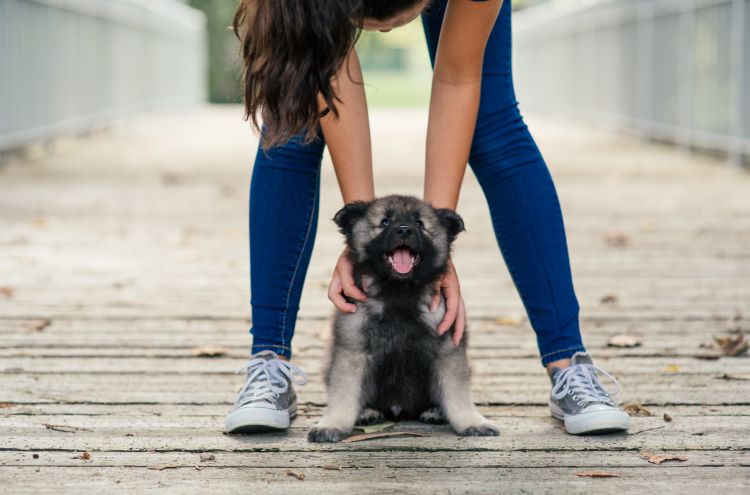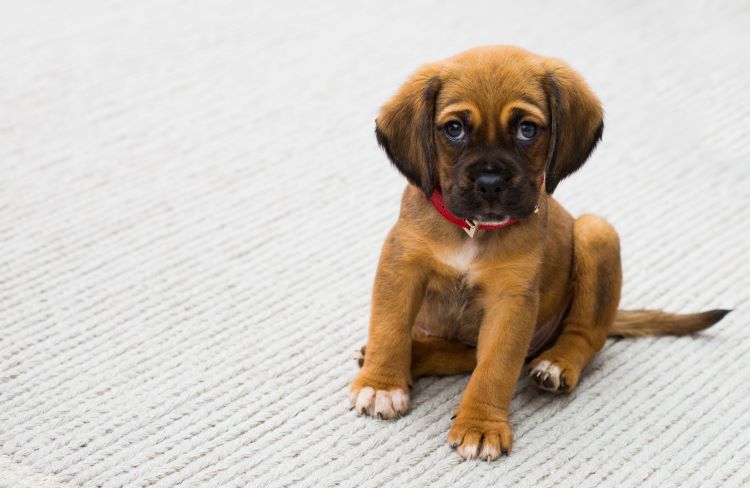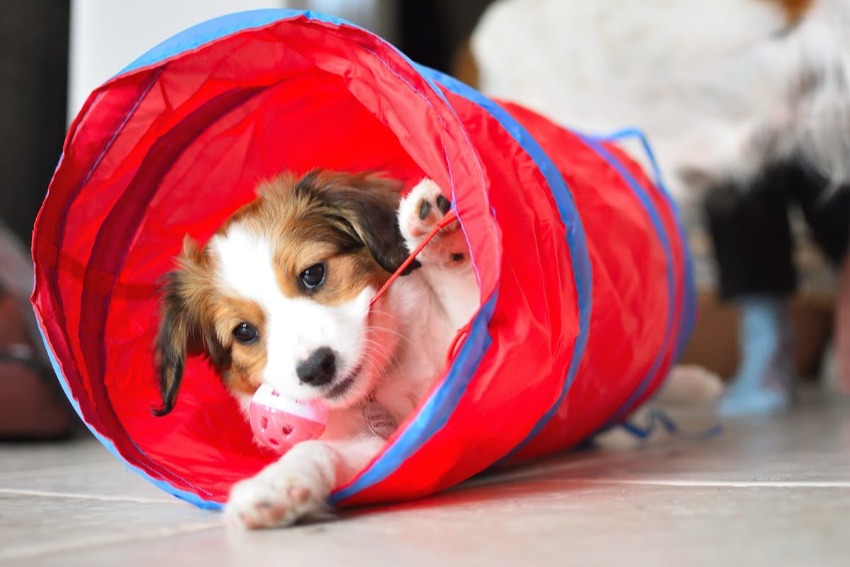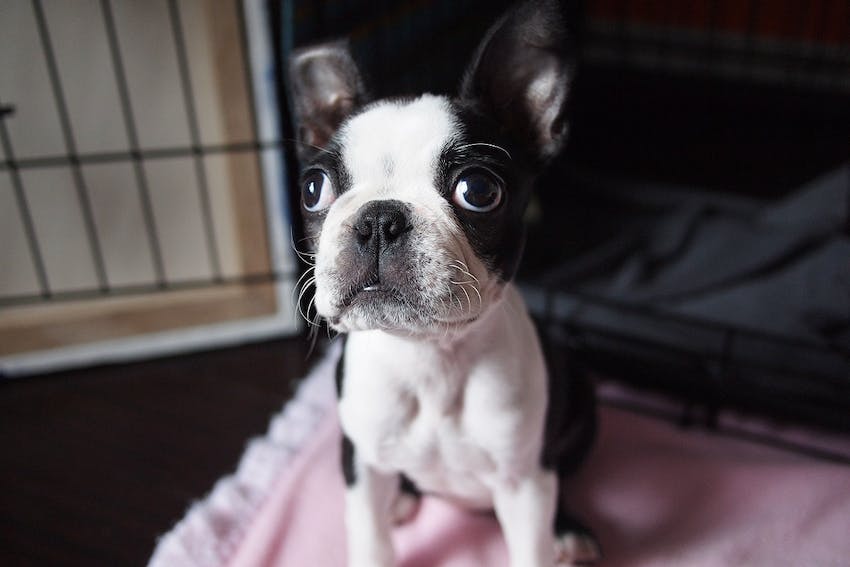Ready to help treat your pet to a healthy life?
9 Puppy Dangers Every Dog Owner Should Know
By : Brianna Gunter | Published Feb 8, 2024

Welcoming a new puppy into your family is an exciting experience, but the fun can quickly screech to a halt if safety isn’t a priority. Amidst all the cuddles and playtime, all pet owners must be aware of the dangers that pose a threat to our furry companions and take the necessary steps to protect them.
Whether you’re a first-time dog owner or an experienced one, there’s no better time than the present to make sure you’re up to speed. Here’s a handy list of nine common puppy hazards inside and outside the home, as well as how you can protect your young pet from each one.
1. Household cleaners
Like humans, puppies need to live in a healthy, clean environment. This naturally involves regular cleaning on the dog owner’s part, but caution should be taken with household cleaners. Puppies are naturally curious, and they tend to explore their surroundings by chewing and sniffing. This behavior puts them at risk of ingesting toxic cleaning chemicals; either through chewing on the cleaning products themselves or coming into contact with a recently treated surface. Pups may also be at risk of toxic ingestion by licking a cleaning substance off of their paws or other body parts that have come into contact. With corrosive chemicals, puppies can also suffer from burns or irritation wherever their skin comes into direct contact.
Depending on the type and amount of substance ingested, the effects on dogs can range from mild and temporary to serious and long-lasting. In some cases, damage to a dog’s health may be permanent or result in death. Signs of toxic ingestion in puppies include vomiting, diarrhea, lethargy, gagging, foaming at the mouth, seizures, and signs of confusion or erratic behavior — seek veterinary advice immediately if you notice any of those signs.
How to protect your pet
If you suspect your dog has ingested any toxic substance, seek emergency veterinary attention right away.
Preventative measures are always the best course of action when it comes to protecting pets from toxic ingestion. Here’s what you can do to protect your pup from household cleaners:
- Store all cleaning products in hard-to-reach places that pets can’t access.
- Ensure all containers are closed securely after use and are not leaking.
- Throw out any unused cleaning products or ones in old and/or broken containers.
- Keep dogs securely away from the area being cleaned.
- Wait for all surfaces to be thoroughly rinsed off (if needed) and dry after being treated with cleaning products.
- Since you can’t predict when accidents will happen or where, protect your pup’s health further with dog insurance.
- Make sure you know where the nearest emergency animal hospital is and save their phone number.
- Do not induce vomiting without consulting with a veterinarian — certain types of cleaners (like bleach) can cause more harm coming back up your pet’s digestive tract.
2. Human-grade drugs
In addition to cleaning products, puppies are at risk of accidental poisoning from human medications. Even seemingly harmless over-the-counter medications can be harmful to pets, as can recreational substances.
While dogs of all ages are at risk of adverse reactions to human-grade drugs, puppies can be particularly susceptible due to their smaller size and developing physiology. Human medications often come in dosages unsuitable for these young animals, posing a risk of dosage discrepancies and adverse reactions. Additionally, certain medications may contain ingredients that are harmless to humans but toxic to puppies. Over-the-counter pain relievers like ibuprofen and acetaminophen, for example, can lead to severe toxicity and potential fatality in puppies.
How to protect your pet
All human prescription medication, over-the-counter medicine products, and recreational drugs should be considered highly unsafe for dogs of any age. If you think your pet has ingested any medication not specifically prescribed for them, contact an emergency veterinary hospital right away or the Pet Poison Helpline.
To help prevent disaster, keep all medications securely stored and be cautious about where you leave pill bottles. You’ll also want to get rid of any extra medications that you no longer take. Last but certainly not least, never give your puppy any drug that has not been prescribed to them by their veterinarian.

3. Human food products
Many common human foods and food additives can be toxic to puppies, including sugar, chocolate, onions, garlic, grapes, and certain artificial sweeteners like xylitol. Ingesting these substances can lead to a range of health issues, from gastrointestinal problems to organ failure and, in extreme cases, even death. Additionally, feeding puppies high-fat or salty human foods can result in pancreatitis or rarely, salt toxicity (sometimes referred to as sodium ion poisoning), both of which can lead to serious health consequences.
Beyond toxicity concerns, allowing puppies to regularly consume human food can contribute to nutritional imbalances, obesity, and behavioral issues. If you have questions about what your puppy should be eating or their nutrition in general, contact their veterinarian.
How to protect your pet
It is crucial for pet owners to be aware of the specific dangers posed by various human foods, keep them out of reach, and provide a well-balanced, puppy-appropriate diet to ensure the health and longevity of our canine companions.
In limited quantities, some human foods can be okay for puppies to eat on occasion (including certain fruits and vegetables). When in doubt, however, it’s always best to err on the side of caution and avoid giving your pet a taste.
4. Fertilizers and lawn chemicals
Many people enjoy having a green lawn and thriving plants, but the weed killers, pesticides, fungicides, and fertilizers involved are highly toxic to puppies. One study even found herbicide-treated lawns to be associated with significantly increased risk of bladder cancer in dogs. Common lawn chemicals have likewise been found to remain detectable on grass well after they’re applied too — at least 48 hours and up to 72 hours in some cases.
Even perceived “safe” gardening treatments can be harmful to pets. Ingestion of organic fertilizers (like bone meal) can cause gastrointestinal upset, bowel obstruction, and sometimes severe inflammation of a dog’s internal organs.
How to protect your pet
No gardening treatments — synthetic or organic — should be considered safe for dogs of any age. If you must use them, talk with your veterinarian about your best options, and keep dogs away from the treated area for three days after application.
If you think your pet has ingested fertilizer, herbicide, or other outdoor treatments, seek veterinary attention immediately.
5. Pest treatments
It’s not just plant treatments pet owners need to be wary of — common pest control sprays, chemicals, and devices can be detrimental to a puppy’s health as well. Both rodenticides and insecticides consistently make the ASPCA Animal Poison Control Center’s annual list of top 10 pet toxins, and they are known to cause seizures, kidney failure, bleeding, gastrointestinal damage, and other health issues in dogs (depending on the type and quantity ingested).
According to the Merck Veterinary Manual, organophosphates are one of the most widely used insecticides and can cause severe reactions in dogs and cats. The Pet Poison Helpline likewise reports hundreds of call a year in regards to organophosphate poisoning in animals.
That said, organophosphates vary significantly in their degree of toxicity and the amount of internal damage they can cause. Increased regulation by the FDA has fortunately contributed to lower amounts of these chemicals being used in today’s pest products, but they should still be regarded as a major poison risk to pups of all ages. As with most other pet poisons, puppies are more susceptible than older animals due to their smaller sizes and the fact that their bodies are still developing.
How to protect your pet
If you think your puppy has ingested any pest poisons, get medical attention immediately. Signs of pesticide ingestion in puppies include vomiting and diarrhea, drooling, abdominal tenderness, decreased appetite, skin irritation, and inflamed mucous membranes.
Naturally, prevention is always best, and pests themselves can transmit harmful bacteria to dogs (and humans). If you have a pest problem, enlist the help of a professional in order to treat the root of them problem and permanently eradicate the pests. You can also look into natural, pet-friendly repellants, but these may not be as effective.
Stay current on your puppy’s routine parasite prevention as well. Rodents in particular can bring fleas and ticks into the home, which can then be easily transmitted to your pet.

6. Plants
Plants are pretty, but take caution with a puppy around — both outdoor and indoor plants can pose serious risks to animals. Popular home plants that are toxic to dogs include:
- Corn plant
- Aloe vera
- Jade plant
- Bird of Paradise plant
- Peace Lily
- Chinese Evergreen
- Palm (Sago palms, date palms, and oleander palms all contain toxins harmful to canines)
- ZZ plant
- Desert rose
- Asparagus plant
- Elephant ear
- Philodendron
- Pothos
- English ivy
Curious puppies may be prone to chewing on plant leaves or stems, which can release potential toxins more quickly and cause gastrointestinal upset, excessive drooling, or abdominal pain. In some cases, toxic plant ingestion can cause slowed heart rate, respiratory issues, and in severe cases, death.
How to protect your pet
Even if you have a plant not on the list above, it’s wise to assume it can at least cause stomach upset in your puppy. Keep all houseplants out of reach of pets. You might also consider adding fences around any outdoor gardens.
As with other puppy toxins, seek emergency veterinary attention right away if you think your pet has ingestion something dangerous.
7. Excessive temperatures
Extreme temperatures can pose significant dangers to puppies, just as they can to adult dogs. Puppies are particularly vulnerable to excessive heat or cold due to their developing bodies and more limited ability to regulate their internal body temperature. Dangers include heatstroke, dehydration, hypothermia, and respiratory distress in general. Brachycephalic breeds like Pugs are especially at risk in high heat, as their nasal structure can make it more difficult to breathe in general.
Signs of distress in extreme temperatures include (but are not limited to):
- Heavy panting / rapid breathing
- Bright red gums and tongue
- Rapid heartbeat
- Confusion or difficulty walking
- Excessive drooling
- Muscle spasms or muscle stiffness
- Excessive shivering
- Lethargy
- Passing out
How to protect your pet
The good news is that there are a lot of things you can do to protect your puppy against dangerous temperatures. Always keep an eye on the weather to start, and be sure to bring a water source for your pet every time you go on a walk or to the local park. Dogs should likewise never be left alone outdoors, and they should always have access to water both indoors and out.
If you do notice any signs of heatstroke, hypothermia, or any other severe reactions to heat or cold, seek veterinary care immediately.
Whether it’s cold or hot, never leave puppies (or dogs of any age) alone in a parked vehicle. Even if the weather feels mild, cars can quickly amplify outside temperatures to extreme degrees. In many states and parts of Canada, it is actually illegal to leave pets unattended in a vehicle.
8. Other pets
Puppies must learn proper socialization and dog training skills in order to interact safely with other pets and people. But sometimes other pets can put puppies in danger. Other pets may not be as well trained, may not have sufficient experience with younger dogs (or in the case of cats, dogs in general), or they may not be up-to-date on vaccinations and parasite prevention treatments. From acts of aggression to spreading illnesses, it’s always important to practice extreme caution with your puppy around other animals.
How to protect your pet
First and foremost, it’s important to train your puppy and equip them with the right skills to interact with other animals. Veterinarians likewise recommend waiting until puppies have had all of their vaccinations and learned basic training skills before put into environments with older dogs. Even with general safety measures in place, however, you can’t always predict incidents. With this in mind, take the following tips to heart before you allow your puppy to interact with other animals in and out of the home:
- Keep a close eye on all animals involved at all times — pets should never be left unsupervised.
- Wait until puppies are a minimum of 17 weeks old, are fully vaccinated, and have learned basic training skills (including socialization) before taking them to a dog park.
- Do not rely on dog parks for initial socialization — social learning in puppies should begin well before then and should be in a safe, controlled environment (if not with their littermates, during puppy classes or one-on-one playdates with other puppies of known vaccination status).
- Remove your puppy from situations where any aggression is shown, by either party.
- Do not enter a dog park if you see dogs engaging in dangerous behavior or acting aggressively, or are unsupervised.
- Get to know other pets’ owners to learn what kind of training their pet has gone through and the home environment they are in.
- Stay current on parasite prevention, as other pets may not be fully protected.
- Sign up for dog insurance before socializing your puppy, just in case there are any accidents requiring medical attention.
- Do not underestimate small dog breeds or cats. Both can act out aggressively if they feel threatened by a puppy and may cause injuries.

9. Unsecured environment
You’ve made sure that you have treats, puppy food, toys, and a cozy dog bed for your puppy, but have you ensured that your home environment in general is safe for them? Puppies have different needs than humans, and things we often do not see as harmful may nevertheless be putting them at risk.
Incidents at home are among the most common puppy accidents, including foreign object ingestion, physical injuries (like fractures), and of course toxic ingestion. Safety starts at home when it comes to puppies, and it’s up to us humans to develop a keen eye for spotting potential dangers and making sure our pet’s environment is a secure one.
How to protect your pet
Always remember that your puppy is in their first stage of life — they are going to be naturally curious and will want to explore everything they can. To keep them protected, ensure all loose objects are picked up, electrical cords are secure, and any loose, jagged surfaces are blocked from access. You’ll also want to ensure all windows and doors are secure and not left open for puppies to fall out of or escape from.
In fact, it’s a good rule of thumb to inhibit your puppy’s access to anything you feel could put them at risk, even if that risk seems small. It’s also a good idea to consult with your pet’s veterinarian about your home environment. They’ll be able to answer any specific questions you may have and can offer insights on how to better protect your puppy.
Learn more about keeping your new pet safe with these essential tips for puppy-proofing your home.
